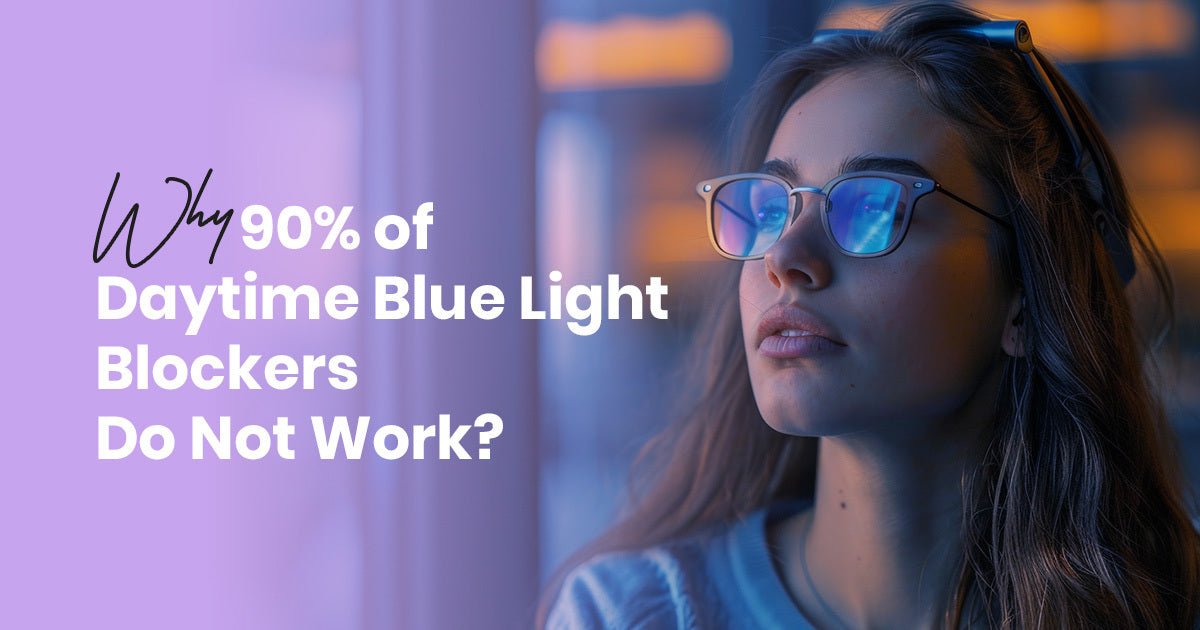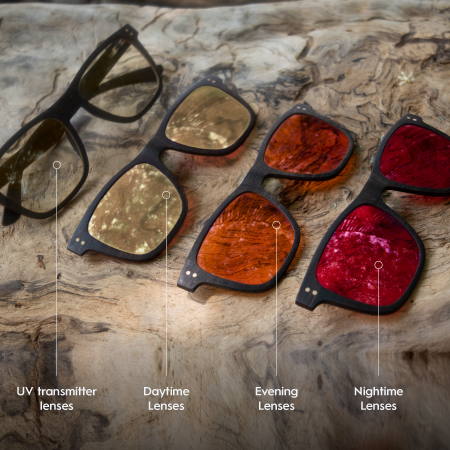Why 90% of Daytime Blue Light Blockers Do Not Work?

Hello and welcome to another fascinating light dive.✨ Today, we're flipping the script on everything you thought you knew about blue light. Brace yourself—this isn't your average "blue light is bad" conversation. It's about how blue light, when harmonized correctly, is actually essential for your energy, focus, and overall vitality.
The Essential Role of Blue Light During the Day

You’ve probably heard it a million times: blue light is harmful, right? Well, that’s only half the story. Blue light during the day is actually a vital part of our circadian rhythm, signaling to your brain that it’s daytime, boosting your energy, focus, and mood. Without it, your body wouldn't know when to be awake and alert. But—and here’s the catch—In nature, sunlight provides a full spectrum of blue light, balanced with yellow, orange, and red wavelengths, ensuring a harmonious blend that’s easy on the eyes. But modern artificial lights? They don't play by these rules.
The Problem with LED Lights: The Unbalanced Spectrum

Unlike the harmonious light provided by the sun, LED lights emit a concentrated, unbalanced spike of blue light at 455 nm. Think of it as an aggressive, isolated frequency with no soothing yellow or red to counterbalance it. This unbalanced spectrum is the root of many modern issues: eye strain, headaches, fatigue, and even inflammation. When our eyes are exposed to this isolated blue light—day after day—it wreaks havoc on our system, leading to inflammation, mitochondrial dysfunction, and a decrease in energy and productivity. It's like overdosing on one mineral or vitamin, which intoxicates the body, rather than taking the full spectrum of minerals and vitamins that nourish the body.
Why VivaRays Daytime Circadian Glasses Focuses on Harmonizing Blue Light at 455 nm

Here’s where we at VivaRays come in. Blocking all blue light during the day isn’t the solution. In fact, doing so can make you drowsy and lethargic during the day, which is the opposite of what you need. Our Daytime Circadian Light Harmonizing Glasses are designed to reduce the harmful spike of blue light at 455 nm while keeping the beneficial blue light (470-500 nm) intact. This balanced spectrum mirrors what you’d naturally receive from sunlight, preserving your energy, alertness, and focus.
Instead of eliminating blue light entirely, our glasses harmonize and balance it with other light frequencies, reducing the inflammatory spike while maintaining brightness and balance, so you can stay energized without the side effects of artificial light exposure.
How Do VivaRays Glasses Compare?
"I’ve tried so many blue light blockers over the years—clear lenses, yellow-tinted glasses, you name it, from all the well-known brands. But none of them really worked for me. VivaRays got the science right. I immediately noticed the difference. My energy levels stayed high, my focus improved, and the headaches disappeared. These glasses are a game-changer! I can’t recommend them enough!"- Jessica, Vivarays client (Verified Review).
You might be wondering: how do our glasses stand up to others? Here's a quick breakdown:
- Clear Blue Light Blockers: These lenses focus on filtering blue-purple light (380-420 nm), which isn’t even emitted by LED screens or modern lighting. Essentially, they are useless.
- Yellow-Tinted Glasses (like RaOptics, boncharge, truelight..): These block 100% of blue light at 455 nm, and they eliminate the beneficial blue turquoise between 470-500 nm, which is extremely crucial to your health and well-being during the day. It helps stimulate the brain, increase focus and alertness, and signal to the body that it is daytime. This over-blocking can cause drowsiness and disrupt your circadian rhythm, making them a poor choice for daytime use.
VivaRays strikes the perfect balance, harmonizing the harmful blue light and amplifying the deficient yellow, orange, and red wavelengths typically missing in artificial light sources.
What About the "Blue Light Pen" Test?
Here’s another myth we need to cover: the Blue Light Pen Test. Many companies market this test as proof of their glasses' effectiveness. But the pen doesn't even emit real blue light! It uses violet light (380-400 nm), which isn’t the frequency causing all the damage. This test doesn't measure your glasses' ability to filter harmful blue light at 455 nm, so don’t be fooled by these marketing gimmicks.
The VivaRays Difference: Harmonizing, Not Blocking
By focusing on balancing and harmonizing the blue light at 455 nm, our glasses decrease the sharpness of the harmful spike while boosting other colors in the spectrum. This results in a more natural light environment that keeps your brain alert and your body energized throughout the day.
With VivaRays, you’re not just blocking blue light—you’re tuning into the balanced, health-boosting spectrum that nature intended.
Best Time to Wear VivaRays Daytime Glasses

You can start wearing them right in the morning when you’re indoors and exposed to artificial light from screens, bulbs, and LEDs. Whether you’re working at the office, studying, or even just relaxing at home, VivaRays Daytime Glasses will help keep you energized and focused throughout the day. Just be sure to switch to our Evening or Nighttime lenses as the day winds down and the sun sets.
Conclusion
At VivaRays, we’re all about helping you thrive in today’s world of artificial light.
We invite you to share this knowledge with your friends, family, partners, and community! The more people know about the benefits of harmonized light, the more we can spread the word and create healthier environments for everyone.
Join the VivaRays Light Revolution and help others live in harmony in our modern world . Spread the word!💜🧡




Awww! This is so lovely to read Christina! Thanks so much for writing this! Our hearts are full of joy reading your feedback. Thank you! Thank you! Thank you! 💛🧡❤️
I had used Bon Charge (former BLUblox) daytime glasses—both clear and yellow lenses—before I discovered VivaRays and I can say that my experience 100% confirms the information shared in this article. There’s just no comparison. The difference in the way I felt when I switched to VivaRays was so obvious. Not to mention the quality of the materials used by VivaRays vs. cheap plastic used by Bon Charge and similar brands. I love my VivaRays so much! Thank you, Roudy & VivaRays Team! Truly. ❤️ (I use VivaRays sleep mask and earplugs, too. Incredible products!)
Leave a comment